The term rotary actuator might not be something that you think about every day, but it is something that you take advantage of every day, in both direct and indirect ways. So what are rotary actuators?
In some ways, you can think about the actuator in the same way you would think about an arm, finger, hand, or leg. By definition, an actuator is operated by a source of energy that is then converted into motion. In the case of an industrial application, the source of energy is usually electrical current. In the case of your finger, hand, arm, or leg, it’s much different. However, in both situations the actuator allows the mechanism – be it hand or robotic part picker – to interact with the environment.
Without actuators life would be incredibly different. Have you ever tried to live a day without the use of your arms? Or maybe you do make do without the use of a limb. In the same way, the industrial world relies on actuators to make many manufacturing processes possible. Without actuators, many of the products we expect to be readily available would be much scarcer.
In simple applications, actuators are predominantly mechanical, providing linear motion in a single direction to provide rotation or movement as needed. While most actuators tend to be powered electrically, many others are also powered with hydraulics or pneumatics. This article will focus on the usage and application of pneumatic rotary actuators.
Pneumatic rotary actuators are very low maintenance units available in different configurations to suit varying applications. Two of the primary configurations often considered for pneumatic rotary actuators include either a double crank mechanism for modulating control or a scotch yoke mechanism that enables on/off control.
A double crank mechanism is exactly what it sounds like, two cranks working in conjunction to provide the needed rotational movement. On the other hand, a Scotch yoke converts the linear motion of a slider into rotational motion by combining a piston with a sliding yoke that then interacts with a pin on whatever part is rotated. This newer and more advanced system allows for fewer moving parts and smoother operation.
Today, pneumatic rotary actuators are used in a number of industries such as petrochemical, food, mining, manufacturing, power generation, paper, and more. Applications range in magnitude from simple machinery to large-scale engineering applications like sluice gates and dams. Because of the diverse and widespread use of rotary actuators the size, power, and possible speeds capable are as varied as the industries they are utilized in.
Autogrip Machinery Co., Ltd. is a rotary actuators manufacturer in Taiwan. We specialize in manufacturing power chucks, special purpose power chucks, collet chucks, stationary chucks, facing heads, rotary cylinders, rotary valve/rotary joint and parts/accessories. If you need further details about Autogrip and our products, welcome to visit our website and feel free to contact us!
Article Source: http://EzineArticles.com/expert/Hank_Moon/1260388
Article Source: http://EzineArticles.com/7118819

